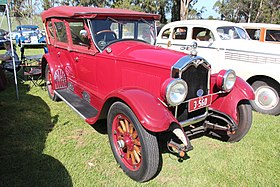Buick Standard Six
| Buick Standard Six | |
|---|---|
 1925 Buick Standard Six | |
| Overview | |
| Manufacturer | Buick (General Motors) |
| Model years | 1925-1928 |
| Assembly | Buick City, Flint, Michigan, United States[1] |
| Body and chassis | |
| Layout | Front-engine, rear-wheel-drive[1] |
| Platform | GM A platform |
| Related | McLaughlin-Buick |
| Powertrain | |
| Engine | 191 cu in (3.1 L) Buick Straight-6 engine OHV I6 207 cu in (3.4 L) Buick Straight-6 engine OHV I6 239.1 cu in (3.9 L) Buick Straight-6 engine OHV I6 |
| Transmission | 3-speed synchromesh manual[1] |
| Dimensions | |
| Wheelbase | 114.5 in (2,908 mm) |
| Chronology | |
| Predecessor | Buick Six |
| Successor | Buick Series 40[1] Buick Series 50[1] |
The Buick Standard Six Series 20 was manufactured by Buick at what would later become known as the Buick City factory on Hamilton Ave. in Flint, Michigan, and was the junior model to the Buick Master Six between 1925 through 1929, and shared the GM A platform with Oldsmobile, Oakland and Chevrolet.[2][1] The Standard Six evolved from the earlier Buick Six when the Buick 4-cylinder was cancelled. The Standard Six was the most popular Buick sold while being more upscale to the Oldsmobile Six. It was the senior brand to Marquette under the General Motors Companion Make Program until Marquette was cancelled one year later. It replaced the earlier Buick Six that was introduced in 1916, and was replaced with the Buick Series 50. Coachwork continued to be offered by Fisher Body who was the primary supplier of all GM products at this time, and Duco automotive lacquer paint, introduced by DuPont was the first quick drying multi-color line of nitrocellulose lacquers made especially for the automotive industry.[1]
Buick Standard Six specifications (1926 data)[edit]
- Color – Brewster green
- Seating Capacity – Five
- Wheelbase – 114.5 inches
- Wheels - Wood
- Tires - 31” × 4.95” balloon
- Service Brakes - contracting on four wheels
- Emergency Brakes - expanding on rear wheels
- Engine - Six cylinder, vertical, cast en bloc, 3 × 4½ inches; head removable; valves in head; H.P. 21.6 N.A.C.C. rating
- Lubrication – Force feed
- Crankshaft - Four bearing
- Radiator – Cellular
- Cooling – Water pump
- Ignition – High tension generator and storage battery
- Starting System – Single Unit
- Voltage – Six to eight
- Wiring System – Single
- Gasoline System – Vacuum
- Clutch – Dry plate, multiple disc
- Transmission – Selective sliding
- Gear Changes – 3 forward, 1 reverse
- Drive – Spiral bevel
- Rear Springs – Cantilever
- Rear Axle – Three-quarters floating
- Steering Gear – Worm and nut
Standard equipment[edit]
New car price included the following items:
- tools
- jack
- speedometer
- ammeter
- electric horn
- transmission theft lock
- automatic windshield cleaner
- spare tire carrier with extra demountable rim
- rear view mirror
- gasoline tank gauge
- parking lights on cowl
- headlight dimmers
- tail lamp
- instrument board lamp
- pressure grease gun
- windshield type ventilator
- dome light
- foot rest
- rear window curtain and sunshade
Prices[edit]
New car prices were F.O.B. factory, plus Tax:
- Five Passenger Coach - $1295 ($22,288 in 2023 dollars [3])
- Five Passenger Double Service Sedan - $1475 ($25,386 in 2023 dollars [3])
- Two Passenger Roadster - $1150 ($19,792 in 2023 dollars [3])
- Two Passenger Enclosed Roadster - $1190 ($20,481 in 2023 dollars [3])
- Five Passenger Touring - $1175 ($20,222 in 2023 dollars [3])
- Five Passenger Enclosed Touring - $1250 ($21,513 in 2023 dollars [3])
- Two Passenger Double Service Coupé - $1375 ($23,664 in 2023 dollars [3])
- Five Passenger Sedan - $1665 ($28,656 in 2023 dollars [3])
- Four Passenger Coupé - $1565 ($26,934 in 2023 dollars [3])
See also[edit]
References[edit]
- ^ a b c d e f g Kimes, Beverly (1996). Standard catalog of American Cars 1805–1942 (third ed.). Krause publications. pp. 162–192. ISBN 0-87341-478-0.
- ^ Georgano, N. (2000). Beaulieu Encyclopedia of the Automobile. London: HMSO. ISBN 1-57958-293-1.
- ^ a b c d e f g h i 1634–1699: McCusker, J. J. (1997). How Much Is That in Real Money? A Historical Price Index for Use as a Deflator of Money Values in the Economy of the United States: Addenda et Corrigenda (PDF). American Antiquarian Society. 1700–1799: McCusker, J. J. (1992). How Much Is That in Real Money? A Historical Price Index for Use as a Deflator of Money Values in the Economy of the United States (PDF). American Antiquarian Society. 1800–present: Federal Reserve Bank of Minneapolis. "Consumer Price Index (estimate) 1800–". Retrieved February 29, 2024.
- Source: Slauson, H. W.; Howard Greene (1926). ""Leading American Motor Cars"". Everyman's Guide to Motor Efficiency. New York: Leslie-Judge Company.

